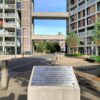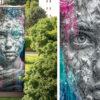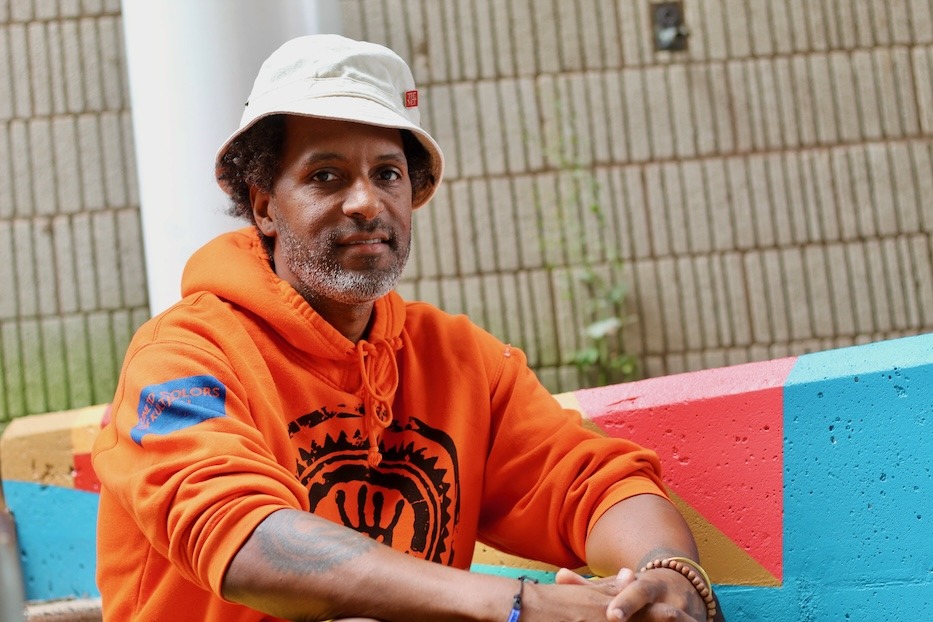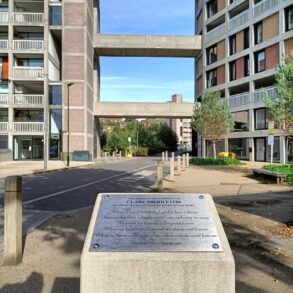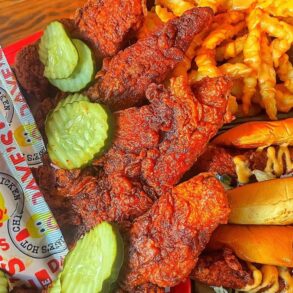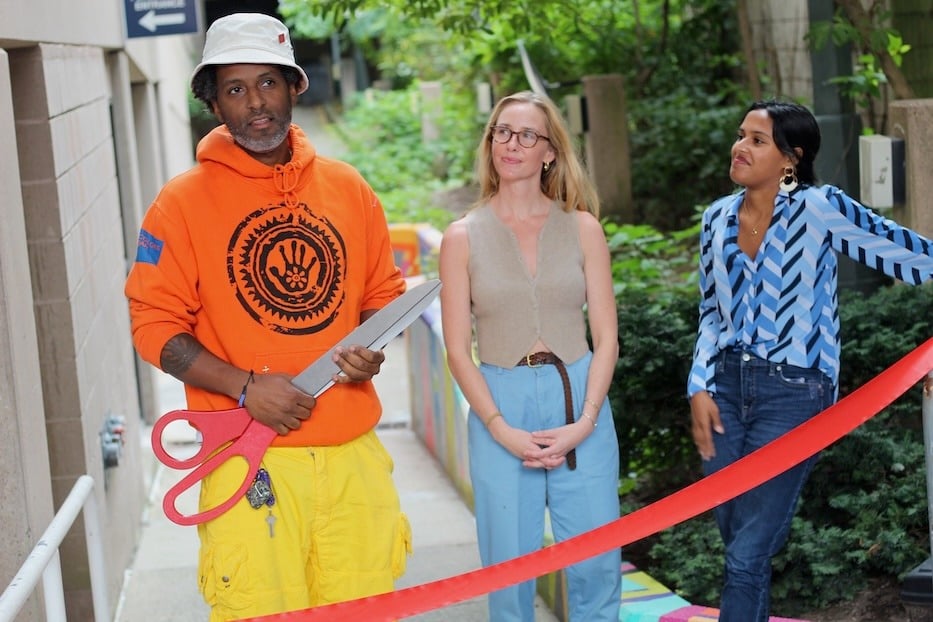

Jahmane, Tara von Schmidt, and Amina Khokar. Lucy Gellman Photos. Video below by Rebekah Moore.
The blocks of color sit side-by-side, so clean and bright against each other that they could be woven. There’s orange, the deep, warm color of marigold; Robin’s egg-blue, strips of pink and purple. A splash of green looks almost like a last-minute patch. As they bloom into being beside an Audubon Street parking garage, they tap into a history of craft that runs from Alabama to Connecticut.
It’s one of the ways that Bridgeport-based artist Jahmane is honoring Gee’s Bend, a tiny Alabama town whose quilters have passed down a specific and time-honored tradition since the early nineteenth century. A collaboration between Town Green Special Services District and the Arts Council of Greater New Haven, the mural now adorns a wall beside the LAZ Parking Garage at 78 Audubon St. The artist, half-jokingly, called the composition Jahz Bend.
In the interest of full disclosure, the Arts Paper is affiliated with, but editorially independent from, the Arts Council of Greater New Haven.
“As a graffiti artist, you pull inspiration from a lot of different things, from fine art to abstract art to sculpture and stuff like that,” said Jahmane, who began his career as a graffiti writer in Norwalk and Bridgeport. “So Gee’s Bend influenced a lot of my graffiti art. I’ve always kept up with it throughout the years.”
For the artist, who grew up in Norwalk, it’s a way to shine light on a history that belongs not just to quilters in the South, but to students of Black history—which is to say, American history—in and beyond Connecticut. Known formally as Boykin, Alabama, Gee’s Bend got its nickname through a painful nineteenth-century history of enslavement, when Joseph Gee started a cotton plantation in 1816.
Gee claimed ownership of both land and people for almost three decades, at which point he fell into financial ruin. When Mark Pettway assumed control of the plantation in 1845, almost 100 enslaved Black people became, under U.S. law, his property. That’s why many Gee’s Bend quilters—including families who have since made their way North, to Connecticut—still have Pettway somewhere in their name.
The quilts, then, are not just pieces of art, but a reminder of how present the history of white supremacy and economic disenfranchisement of Black Americans is today.
When he talks about the quilts, Jahmane is quick to dismiss the starry-eyed romanticism that sometimes comes with a historical narrative of resourcefulness. For decades, and then over a century, the quilts grew out of a fundamental need to survive. Quilters—enslaved Black women, whose families later remained on the land as sharecroppers (still a form of economic disenfranchisement by white land owners)—created their economical, striking and sharp designs from worn and discarded clothing scraps.
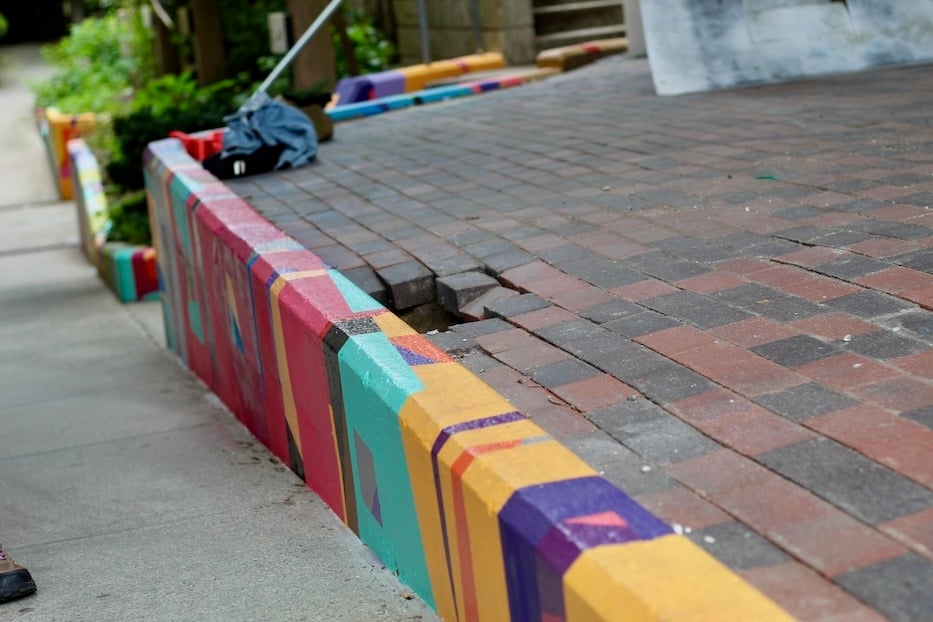
Only in recent years have the quilters come to national prominence, thanks to both organizations like Souls Grown Deep, dedicated to preserving cultural history in the South, a growing handful of exhibitions that recognize the craftwork and artistry, and the rise of social media sources like Instagram and TikTok.
But Jahmane, who has had a kind of reverence for visual art since he can remember, discovered the quilters and their work in his middle school library decades ago. After seeing the vivid, precise geometric designs, he was hooked. He would learn, years later, that his interest in graffiti drawing primed him for work in public art.
“I can remember being infatuated by the colors on the cover of a book, and then seeing the quilts,” he said. It corresponded with his own humble beginnings in graffiti, which he started as a teen in the 1980s. “Ever since then, I’ve always found different information about Gee’s Bend.”
For him, it’s a way to tell a story of craft and migration that is both uniquely Black and uniquely American. With the Great Migration, several Pettway descendants moved to Bridgeport, where they and their families still are today. As he deepened his study of craft, Jahmane got to know several of them, including author Tangular Irby. Her children’s book, Pearl and Her Gee’s Bend Quilt, is inspired by Irby’s grandmothers, Pearlie Kennedy Pettway and Jensie Lee Irby.
Because he came of age with the birth of hip hop in New York—Jahmane is 49, and hip hop is 51—he also thinks a lot about how his work intersects with Black identity and culture. While the quilts are one starting place, his own baptism into breakdancing and graffiti is another. While their history is centuries apart, there’s something about sheer and organic Black genius and artistry that binds the two.
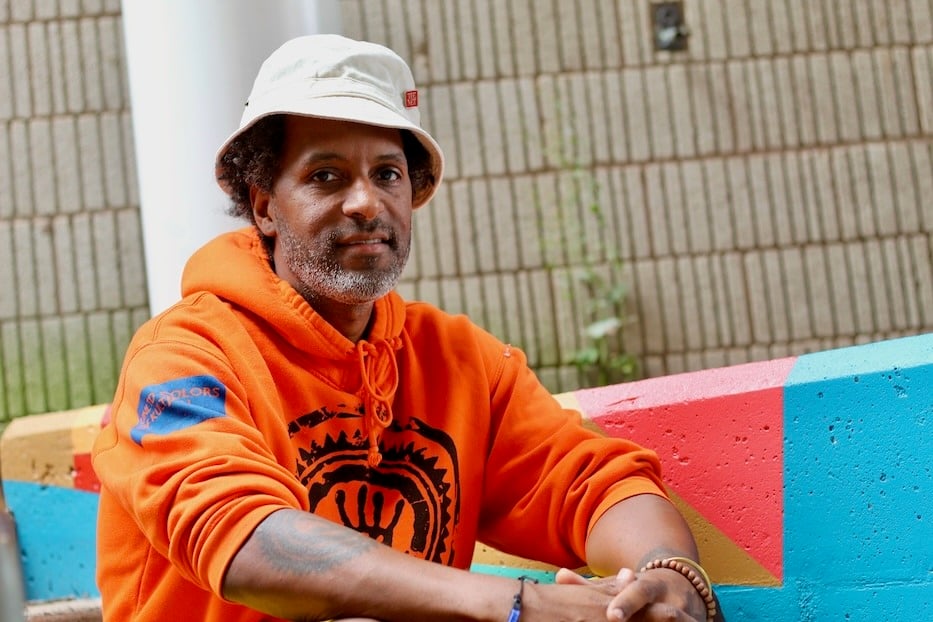
Jahmane: “It looks like it belongs here, you know?”
So when Town Green reached out to him, he was excited to blend his love for graffiti and interest in Gee’s Bend. In the past few years, he’s been working to grow his footprint across the state, with work in the 6th Dimension Afrofuturism Festival (now the Black Futures Institute) in Hamden and New Haven, Norwalk Artspace, and Read’s Artspace in Bridgeport all in the last year.
“Once I saw it, I was like, ‘That’s a nice wall,’” he said. “It’s a nice location and I could see something going on that. It was definitely inspirational when I saw it. It looks like it belongs here, you know?”
Prior to painting, he said, he didn’t spend much time in the so-called Audubon Arts District, much less notice a wall tucked back from the street. Now, he’s proud to have made his mark on the space—and in so doing, create a district that is a little more representative of the city it serves. While the base coat of the work comprises enamel paints, most of the designs are done in spray paint.
Because skateboarders and students from ACES Educational Center for the Arts (ECA) also use the space, Town Green has allocated extra funding specifically for maintenance and repair.
Tara von Schmidt, special projects manager with Town Green Special Services District, praised the mural as a welcome new addition to the neighborhood. At a recent ribbon cutting, she hoped aloud that more murals would follow. Town Green has enlivened much of downtown with its Straight Up Art initiative, notably in the Ninth Square and two downtown plazas.
“We’re so grateful and proud to have this art piece in downtown New Haven,” she said. “I think Jahmane’s piece is perfect in contributing to the community conversation for public art, and the power that that has.”
“As a quilter, I think this is such an important piece,” added Amina Khokar, a former Arts Council employee who now manages the LAB at ConnCORP in Hamden. “It’s unassuming, and then once you do the research and learn about it, it opens up the history.”
This post was originally published on this site be sure to check out more of their content.

